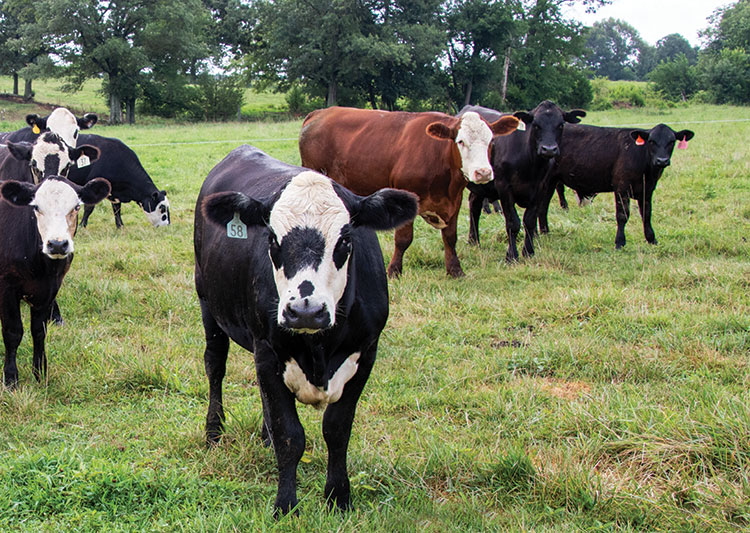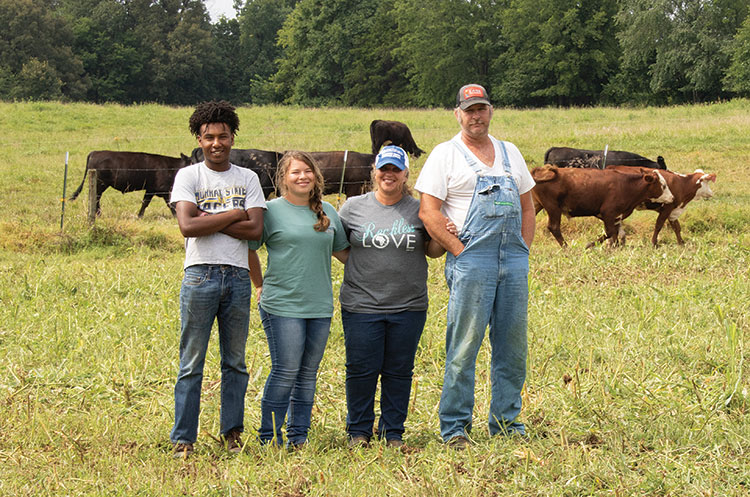Diverse strategies lead to “Choice” grass-fed beef |
| By C.J. Weddle |
|
|
 Multiple forage resources combined with rotational grazing are responsible for a successful grass-fed enterprise at Palmer Farms. Milking dairy cows everyday became monotonous and tiresome for Mike Palmer as a young farmer, which is why he transitioned his grandfather’s dairy farm near Murray, Ky., into a grass-fed beef operation. His family has been farming the same land for generations. Mike’s great-grandparents owned and farmed a quarter section in their prime. But as time passed, the Palmer family didn’t retain all of the original acreage. These days, Mike, his wife Stacie, and their children raise beef cattle and tobacco on 200 acres that they own or rent from neighboring farms. Minus about 15 acres of tobacco, the rest of the land is utilized as permanent pasture. Mike and his family moved into grass-fed beef in 2011 when 11 heifers did not breed, and they decided to feed them out. After contacting a local USDA slaughterhouse, the Palmers entered the grass-fed beef market. Beginning with those open heifers, Mike now has more than 40 market animals, which range from weanlings to finished cattle, on his pastures at any time. Your choice Palmer Farms’ cattle are grass-fed from the day they are born until they leave the farm for processing. Yes, the carcasses grade Choice. Mike said he doesn’t know many people who want a lean steak even if it is grass-fed, so he gives them a choice: his Choice grade, grass-fed beef, or other farmers’ lean grass-fed beef. “If you can grow forages to make a Jersey cow give richer milk than she already does,” Mike theorized, “you can grow forages to make beef cattle gain weight with great marbling.” Learning this feeding trick from his grandfather, that is exactly how Mike manages his 40-cow herd. So, what is he using to meet his final product goals? Mike’s summer pastures are heavily populated with crabgrass. Although crabgrass is a warm-season annual, if it’s allowed to produce viable seed at least once during a growing season, the forage will persist for multiple years. Some of the pastures have a healthy stand of Kentucky 31 tall fescue. The toxic forage is most potent during the summer months. Mike noted, “It’s not detrimental to your animals or your gain if you graze it in the early spring and again later in the fall.” Multiple feeding strategies Apart from these two grasses, the Palmers utilize Marshall ryegrass as a winter annual. “Some years we are planting the ryegrass before the crabgrass plays out,” he mentioned. For 2021, Mike plans to use spring oats as a forage crop on his farm. “We’ll plant in the fall, and when it’s ready, we’ll greenchop it and feed it that way,” he explained. Mike capitalizes on a variety of feeding methods. Of course, he is rotationally grazing, but sometimes conditions do not always allow it. Weather, forage growth, and other farm activity can prevent the Palmers from intensively moving their cattle. “In the spring, we have the time and grass to move them every day,” he said. “But when tobacco harvest starts, we usually give them a bigger paddock and leave them on it longer.” A flail chopper allows Mike to utilize the forages on rented farms that do not have the best fences. Without moving his cattle to the rented acres, he chops and feeds as much forage as he needs. Mike also has a bunker silo that he fills with ryegrass. This silage, coupled with the dry hay that he bales, provides for the finishing animals during the two to three months of winter. The goal at Palmer Farms is to have cattle finished at the 24-month mark. Some finish at 18 months, while others take 26 months. “The range of finishing time works out well for us since we only process two head at a time,” he noted. “It wouldn’t be practical for all of the cattle to finish in the same month and have to wait several more months before we can get them to the butcher.” Palmer Farms hosted a pasture walk this past summer as part of the 2020 Western Kentucky Summer Forage Tour, which focused on forages for grass-fed beef. Showcasing a University of Kentucky demonstration forage plot, the Palmers also highlighted their diverse strategies using crabgrass and grass silage. High demand With a standing appointment at the butcher, the family is constantly restocking their freezers. “Having an appointment for two animals every other week kept us well stocked until COVID-19 cleaned us out,” Stacie explained. She manages the direct sales of their grass-fed beef. Some of her favorite places, and highest demand markets, are local farmers markets. Bringing multiple coolers full of meat, Stacie sometimes sells out before the event is over. To avoid shortages, she fills preorders to bring along with her normal stock. In doing so, her loyal customers know that their meat is available, and Stacie has the opportunity to draw in new customers as well. To ensure product year-round and meet customer needs, Mike has split his herd into four calving groups. The largest group of calves is born in the spring, and he avoids having calves born in the heat of summer or the middle of winter. Although some people may shy away from a grass-fed label, the Palmers have customers who brand them as “their farmers,” only buying beef from their farm. “I don’t want to be able to tell the difference between my grass-fed beef and a neighbor’s grain-finished beef,” Mike remarked. “People think if it’s not grain-finished, it’s not good. We are working to change that thought around here.”  Production and marketing duties are shared by members of the Palmer family. From the left are Teshome, Jessie, Stacey, and Mike. Build client relationships The Palmers do not depend on traditional advertising; rather, they believe in partnering with charities and other organizations for fundraising events and building relationships with those communities. Currently featured on their website is 147 Million Orphans, a faith-based group whose mission is to provide food, water, medicine, and shelter to some of the most vulnerable people on earth. “We adopted our son, Teshome, from Ethiopia,” Stacie said. “So, our hearts are very close to adoption and agencies helping orphans.” Social media is another marketing option that Stacie has nearly mastered. By joining a couple of Facebook groups, she has developed strong relationships with these customers. The loyalty and support of these groups has resulted in Stacie and her daughter, Jessie, loading their van with coolers packed with grass-fed beef and taking a road trip to Evansville, Ind., for bulk order deliveries once a month. At the farmers market, the Palmers focus on customer relations. “Mike and I chat with our regulars and introduce our farm and products to potential new customers,” she said. Cuts of meats are not the only products the Palmer’s grass-fed beef cattle provide to the customers. Twenty-year-old Jessie is able to run a successful Etsy shop selling cosmetic products made from beef by-products. Stacie brings tallow and bones home from the butcher. While the bones are sold as dog treats, the tallow is used by Jessie to make value-added cosmetics and sold through her Etsy shop. MOO-ving forward Taking things one season at a time, the Palmers always look for opportunities. “If you don’t find opportunities and try new things, there is no room for growth or improvement,” Mike said. “You will do the same thing, the same way, over and over.” One of the opportunities that Mike looks for is research projects and results. “There are grants for on-farm research projects,” he noted. He considers it a win for the operation to be an active part of research while learning how his farm can perform and benefit. A personal project he would like to see on his farm entails a sheltered lot for finishing grass-fed beef. Having the flail chopper and wagon, grass silage, hay, and the space to do it, Mike theorized that he can achieve consistent gains year-round by providing more comfortable conditions with a sheltered lot. “In the summer, the cattle would have shade,” Mike explained. “In the winter, they would have protection from the wind and rain. I have the equipment and forages to provide greenchop during the peak growth season or store it as hay and silage for later, so the beef will still be grass-fed start to finish.” He added that his plans for this structural addition would only to be to shelter cattle from harsh conditions or to use during his calving seasons. In favorable weather, Mike expects to have all of his cattle out on pasture. Mike and Stacie plan to raise grass-fed beef for many more years. Their children are weighing career options, but should they choose to return to the farm, their helping hands will be welcomed. For more information on Palmer Farms and the products offered, visit palmerfarmsbeef.com, find them on Facebook at Palmer Farms Grass Fed Beef, or shop Jessie’s Etsy page at etsy.com/shop/hickorygrovecorner. This article appeared in the March 2021 issue of Hay & Forage Grower on pages 22 and 23. Not a subscriber? Click to get the print magazine. |
